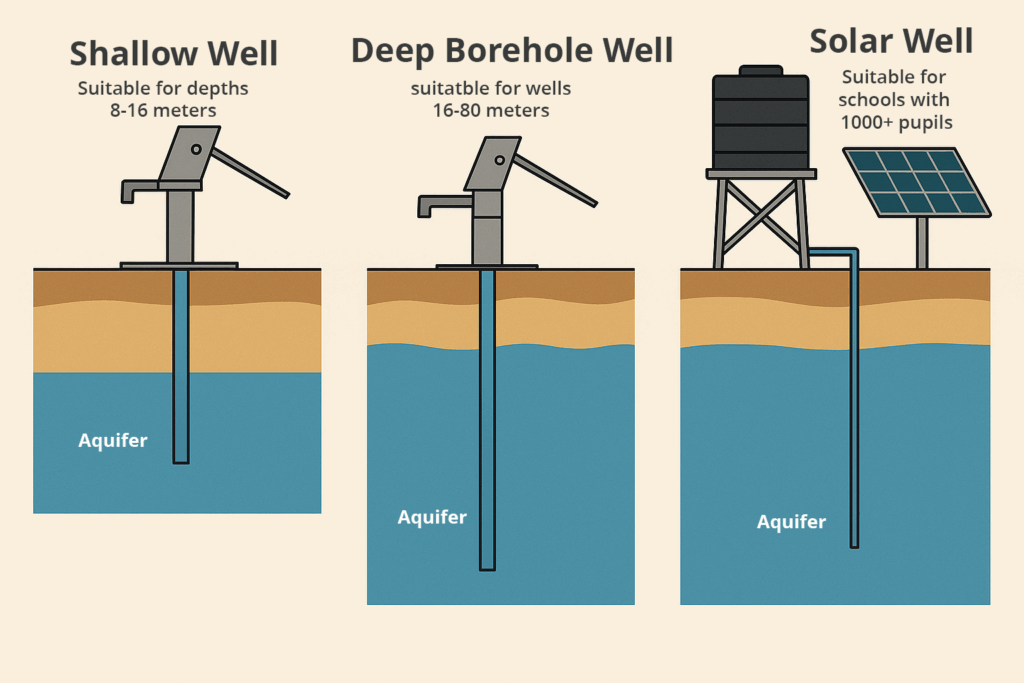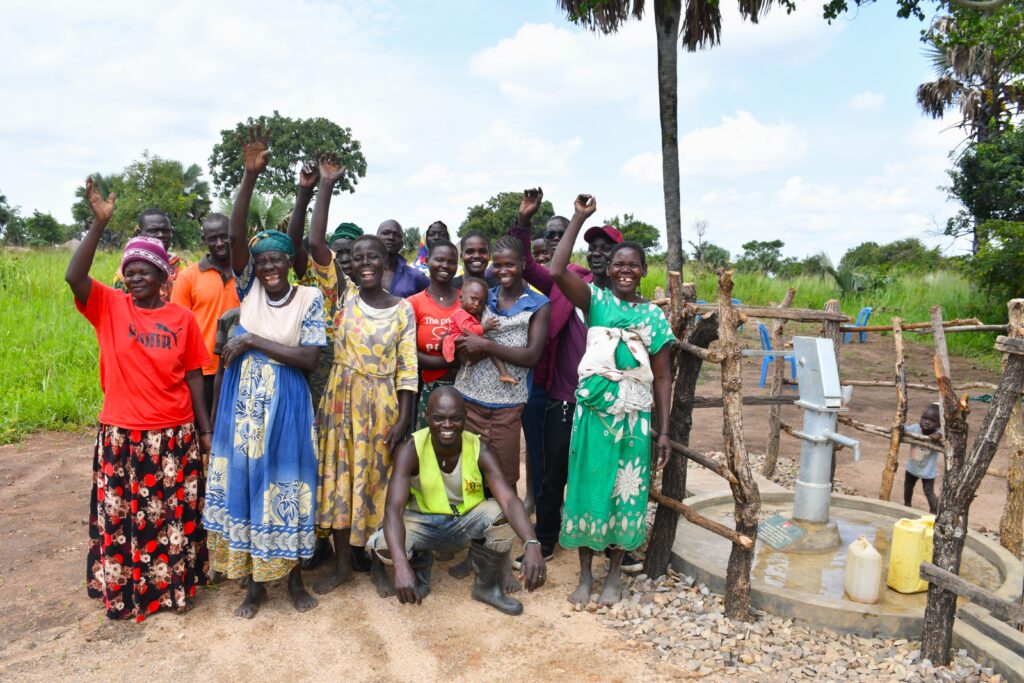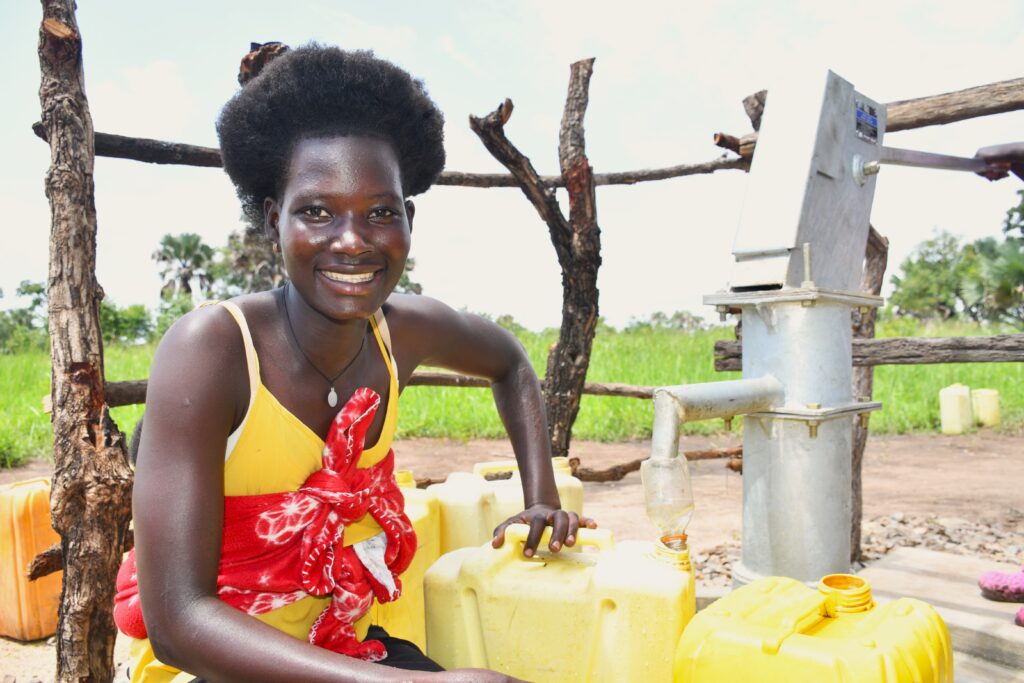There are a lot of factors that determine the cost of a water well in Africa. In a country where the water table is very deep (100 meters or more) it will cost significantly more to drill a well than in a country where the water table is relatively shallow (30 meters or less). Also the availability and price of materials will make a difference to the cost. For example a 50 meter deep borehole in Uganda will cost about $7,500 to drill, but that same well in South Sudan will cost significantly more due to the fact that all of the materials will have to be imported from countries where they are manufactured or more readily available. A well in a mountainous area where you have to drill through very deep volcanic rock to reach an aquifer will cost considerably more money due to the wear and tear on drill heads and the fact that a regular hand pump (India Mk ii) is not as efficient and depts greater than 90 meters.

What Affects the Cost of a Water Well?
• Location, soil conditions and availability of materials
The most commonly used hand pumps in sub-Saharan Africa are the India mk ii pumps. These are an open source pump -meaning anybody can manufacture and sell them without having to pay a licensing fee. If you are drilling a well in a country where someone is manufacturing these pumps, it will be considerably cheaper than drilling that same well in a country where the pump has to be imported. Along with the transportation costs, you may also have to factor in import tariffs or VAT (Value added tax).
Availability of materials is also a factor in determining the total price. For instance you can buy hand pumps cheaper in Kampala (the capital city) considerably cheaper than in some of the more remote villages.
• Depth required to reach safe water
Wells are either drilled to an aquifer (a large naturally occurring underground reservoir of water) or to fractures in the rocks that are filled with a reservoir of water that naturally recharges over time. The depth from the surface to the point that you reach water and the type of rock that you have to drill through can also affect the cost of wells in a certain area. For instance shale and volcanic rock take more time to drill through than dirt or clay and will also wear out the drill bits faster. The ease or difficulty factor in drilling a well can also affect the cost.
• Pump type (manual vs. solar-powered)
• Transportation and drilling logistics
When Drop in the Bucket sends our drilling team to a remote area, we do everything we can to make the trip as efficient—and cost-effective—as possible. Transporting a drilling rig, an air compressor, and a full crew isn’t cheap, especially when the destination is several hours away over rough terrain. In fact, transportation is often one of the largest expenses in the entire drilling process.
That’s why we try to drill at least ten wells at a time whenever we mobilize to a distant region. Instead of bearing the full cost of transporting heavy equipment and personnel for a single well, we spread that cost across multiple projects. Each well shares a portion of the transportation expense, making it far more economical per site.
For example, if we were to drill just one well in a village located four hours from our nearest base, the cost of that project would be disproportionately high. But if we drill ten wells in the same general area, the transportation cost is divided among all ten, significantly reducing the average cost per well. This strategy allows us to maximize donor impact, make the most of our resources, and reach more communities with clean, safe water.
• Permits, community training, long-term maintenance
What’s Included in the Cost?
• Site survey and hydrogeological study.
• Drilling, casing, and gravel packing
• Hand or solar pump installation
• Community mobilization, sanitation and hygiene training
• Monitoring and sustainability plan
Cost Comparison by Country
• Example: Uganda, South Sudan
A deep borehole well drilled by Drop in the Bucket in Uganda should cost around $7,500. That same well drilled in South Sudan will cost over $10,000. The reason is that we can get get all of the materials we need in Uganda – meaning the cement, the fuel, the riser pipes and the pump parts. For the same well in South Sudan we would have to buy all of the items in Uganda, transport them to South Sudan, incurring fuel and import tax costs.
• Why remote or post-conflict areas can cost more
These transportation and import duties are two reasons why it can cost more to work in remote or post-conflict areas, so why work in such difficult areas? Well, there are many great organizations doing excellent, life-changing work in the WASH sector and at DROP we appreciate and applaud all of them. However, for us, we didn’t really see any reason to go and work in areas where there were lots of other charities doing similar work, so when we started working in northern Uganda, there were only a handful of organizations drilling wells and even fewer in South Sudan. Because we are fortunate to have such supportive and generous donors who understand why we are doing this work, we are able to work in places that some may find too expensive or logistically challenging.
• Why Drop in the Bucket focuses on schools and health centers
Drop in the Bucket prefers to work in schools and health centers, because these are the places where we see the most need. In rural areas, health centers are where women go to deliver their babies, so the need for clean water is vital and can mean the difference between life and death. Drop in the Bucket drills wells at schools because children, usually girls, are often the ones tasked with fetching water for their families so by drilling wells at schools we make it possible for children to attend school and get an education. Kofi Annan, the seventh Secretary-General of the United Nations once famously said that that there is no tool for development more effective than the education of girls. In his address he cited the impact on economic productivity, infant and maternal mortality, nutrition, health, and the education of future generations.
Case Study: Drilling a Well in Northern Uganda
This story from the well DROP recently drilled at the Abegu village in Gulu, northern Uganda underscores the importance of clean water and shows the difference that it can make in peoples lives. These photos show the new well. Before the well the villagers would walk to a local water hole. It took one hour in each direction and most families would have to make the walk twice each day. This meant that they would lose for hours every day just due to fetching water. To get to the waterhole, the people from the village would have to walk along a narrow, overgrown path. This presented some danger to the people of the village who were nervous about potential danger. Now that the village has a well nearby this is no longer an issue.



• Women and girls no longer have to spend hours walking for water
• Children, particularly girls are no longer putting their lives in danger walking through unsafe areas to get water
• The community members are no longer wasting hours every day walking for water can now spend their time doing more productive things like attending school or earning money. To learn more about this project click this link.
How You Can Help
Donate towards funding the construction of wells.
Can I sponsor a well in a specific village?
If you are looking to raise money to fund a well that you get to name, you can set up your own fundraiser page and once you have reached your goal, we can place an engraved tile on the well, with the inscription of your choice.
Drop in the Bucket works with the local school authorities, the district water office and the Ministry of Water and Infrastructure. We do not drill wells without a lot of planning, so if you need a specific well at a relative’s house or at a place of business, you may want to consider contracting the services of a for-profit construction company that owns drilling equipment for your project. That said, if you are an NGO or other organization that is supporting a specific school in one of the areas where we are working, you are welcome to get in touch with us about your project and your needs. DROP does not fund outside projects, so if you were hoping for us to fund your project, that is not something we are able to do.
How long does it take to drill a well?
the short answer is, if you are just talking about construction it can take just 3-4 hours to drill down 50-60 meters, but for a longer and more detailed response use this link.
Can a group or school fund a water project?
Yes, if you and your friends, family, school, church, business or group would like to raise the funds to get a well drilled in Uganda, you can either donate the cost of a well using this link, or set up a fundraising page using this link.
Donate
Connect with us
Follow us on Facebook
Follow us on Instagram
Sign up for our email newsletter
